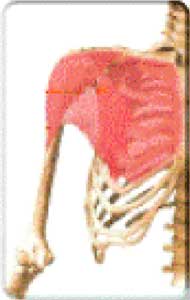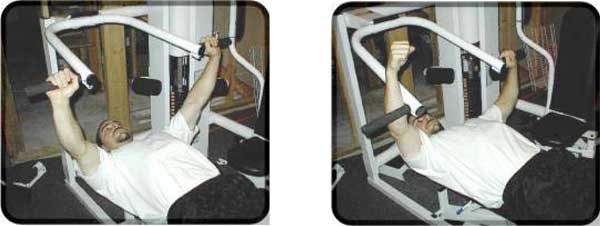Universal Machine Press Techniques

Why Is This Exercise So Effective?
The main value of this machine is not in its primary function (the plain, flat bench press) but in the variations of the bench press that you can do on it. The exercise is done essentially the same as a Flat Barbell Bench Press with the notable exception that it is done on the Universal Bench Press station.
How To Do It
General Tips
- Make sure the handles are in line with your middle to lower pecs at the bottom of the movement.
- Don’t allow the weight stack to touch between reps.
- If possible, move the bench so you can hook your knees over the edge. This will keep your body from sliding back towards the stack as you may have a tendency to do on a smooth bench. This happens because your arms push down towards your feet during the movement. Since the bar is anchored and your body is not, your body will move. The knee hook will prevent this.
Two-Up One-Down Negatives

The Universal bench press machine is a very effective machine for doing two-arms up, one-arm down negatives (where you press up using two arms and lower the weight using only one). Here is how to do them:
- Start by assuming the regular bench press position. Press the weight up to the top as you normally would.
- Now remove one hand from the bench handles and brace that forearm against the outside of the inner perpendicular bar (see picture at top-right).
- Pull in actively with your non-supporting forearm for even better stabilization.
- This keeps you from rolling over and keeps the other hand from helping too much.
- Be quick when you go from gripping with two hands to bracing the forearm.
- Your foot placement will be askew from normal because of the unbalanced forces involved. The leg that is the same side as the working arm will be in close while the other leg will be kicked out wide to help counterbalance.
How to incorporate this exercise into your workouts:
This exercise is best done as a stand-alone exercise due to it’s demanding nature.
- If you have worked the negatives properly and with intensity, no further work should be done for the chest on that day.
- Your pecs will be toast, in other words.
Partials
The Universal bench can also be used for doing partial presses (both bottom and top range)
The bottom range partial can obviously be done without any adjustment to the machine at all. Simply set the weight to approximately 75% of your max and do only the bottom range of motion. Be sure to let the weight stack settle completely between reps to totally remove all elastic tension in the muscles.
Top range partials can be accomplished by lifting the handles up a little then setting the pin back in the stack with the handles raised up. This keeps the handles elevated, allowing you to start your press from that position.
If there isn’t enough weight available to do heavy partials after raising the handles, do them one arm at a time.
How to incorporate this exercise into your workouts:
This exercise can be done as a solo movement or incorporated into a chest workout.
- The reason this partial movement can be included in a full chest workout is that most chest press machines won’t have enough weight to work your chest so hard that you can’t do anything else.
- It basically a judgment call on your part. You may find that you can work your chest hard enough that you feel you shouldn’t do anymore chest work that day.
- Listen to your body.
Swiss Ball Presses
The Universal bench machine is an excellent option for doing presses on the Swiss Ball. It is especially useful if you are just starting out with the ball and could use a little stabilization on the resistance.
- Set the ball under the handles and lie back on the ball with you feet on the floor.
- Press from there.
- You will most likely need to adjust the position of the ball a little bit before you find the point where it is most comfortable.
- Using the ball for the press helps you to open up your rib cage, increasing pectoral fiber activation.
For an extra challenge, lift your feet off the floor while you are benching.
- This will increase the instability of the exercise. Instead of your feet stabilizing your body and only the weight moving, now your feet are out of the equation. The weight is still moving but it’s locked into it’s movement pattern.
- It is a very different sort of feeling, being completely the opposite of how you normally stabilize your body during a bench press movement.
- You will find that it also works your abs quite well to be holding your legs off the ground during the set while you are using your torso muscles to stabilize everything.
How to incorporate this exercise into your workouts:
This exercise should be placed first in a chest routine.
- The reason it should be first is the amount of stabilization required for this exercise.
- You will be using your arms and chest to stabilize your body, which is completely the opposite of how you normally stabilize your body (with your legs).
- If you fatigue your chest muscles, you will diminish the quality of the exercise.


